Abstract
There is a magmatic lull period in the East Kunlun orogen (EKO) during the Jurassic to the Cretaceous. However, due to the lack of records of magmatic activity restricts our understanding of the late Mesozoic magmatic-tectonic evolution of the EKO. Herein, an integrated study of geochronology, whole-rock geochemistry and Sr-Nd isotopes were conducted for the Cretaceous mafic dykes in the EKO, Northern Tibet Plateau, to reveal their petrogenesis and geodynamic implications. LA-ICP-MS Zircon U-Pb dating reveals that the studied mafic dykes comprising diabase and diabase porphyry emplaced at ca. 80.9 ± 0.8 Ma. The Cretaceous mafic dykes have low contents of SiO2 (46.36 wt.%~47.40 wt.%) but high contents of MgO (6.79 wt.%~7.38 wt.%), TiO2 (1.91 wt.%~2.13 wt.%), Nb (12.4~18.3 ppm) and Nb/U ratio (31~39), resembling Nb-enriched mafic dykes. They exhibit chondrite-normalized rare earth element (REE) and primitive mantle-normalized trace element patterns, remarkably similar but not identical to the oceanic island basalts (OIB). The moderate REE fractionation ((La/Yb)N = 3.55~5.37), weak negative Eu anomalies (δEu = 0.87~0.97) and relative enrichment of Rb, Ba, K, as well as high contents of Cr and Ni and slightly depleted Sr-Nd isotopes (εNd(t) = −0.18~1.33), suggest that the studied dykes originate from a partial melting of spinel lherzolite and a little of garnet which was previously modified by subducted sediments. Combined with other evidence, we propose that the studied Cretaceous Nb-enriched mafic dykes in the Northern Tibet Plateau were formed in the intraplate setting, which may be a partial melting of the enriched mantle in the lower lithosphere caused by the activity of the East Kunlun strike-slip fault.
1. Introduction
The East Kunlun orogen (EKO) is a composite accretive orogenic belt in the northern Qinghai–Tibet Plateau, which has experienced Proto-Tethys and Paleo-Tethys orogenic cycles and developed large-scale early Paleozoic-Triassic magmatic batholiths [1,2,3]. Following the post-collisional extension in the late Triassic, the EKO entered the intracontinental orogenic stage [4,5,6]. There is a magmatic lull period in the EKO during the Jurassic to the Cretaceous. However, due to the lack of magmatic activity, the study of the late Mesozoic in the EKO mainly focused on low-temperature thermochronology and sedimentology [7,8,9,10,11,12], and there are few reports on magmatic rocks in the Cretaceous, which seriously hinders our understanding of the Cretaceous magmatic-tectonic evolution in the EKO.
Nb-enriched mafic rocks are a kind of magmatic rock with special geochemical characteristics and petrogenesis. Compared with island arc basalts, they have high Nb (>7 ppm) and TiO2 (>1 wt.%) contents and high Nb/La ratio (>0.5) [13,14,15]. The high Nb content of Nb-enriched mafic rocks is mainly due to the addition of deep mantle material or subducted sediment melt, or both, in the source [16]. Nb-enriched mafic rocks are usually formed under the background of island arc, back-arc extension or mantle plume, and they are often associated with adakite all over the world [13,15,16,17,18,19]. There is still debate about the petrogenesis of Nb-enriched mafic rocks. At present, it is mainly suggested that it was formed by magmatic mixing between OIB-like melt and depleted MORB-type melt or the subduction-related melts metasomatized the mantle wedges [13,17,20]. Thus, they are of great significance in tracing mantle properties, geodynamic processes and tectonic settings. Thus, the newly identified Nb-enriched mafic rocks in the EKO are an ideal object in terms of studying the magmatic-tectonic evolution in the northern Qinghai–Tibet Plateau. Herein, we present studies on petrology, LA-ICP-MS zircon U-Pb chronology, geochemistry and Sr-Nd isotopes to constrain the petrogenesis and tectonic setting of the Cretaceous Nb-enriched mafic dykes in the EKO, which may provide a good understanding of Cretaceous magmatic-tectonic evolution in the northern Qinghai–Tibet Plateau.
2. Geological Setting and Petrography
The Kunlun orogenic belt, located on the northern margin of the Qinghai–Tibet Plateau, is an important part of the central orogenic belt in China, which is divided into East Kunlun and West Kunlun by the Altun fault (Figure 1a) [1]. The EKO extends about 1500 km from east to west and is adjacent to the Qaidam basin in the north and the Songpan–Ganzi terrane to the south, separated into West Kunlun and West Qinling by the Altun fault and Wenquan fault, respectively (Figure 1a) [1,2]. The EKO can be divided into the South Kunlun Block (SKB) and North Kunlun Block (NKB) by the central Kunlun fault and the south Kunlun fault (Figure 1b) [21].
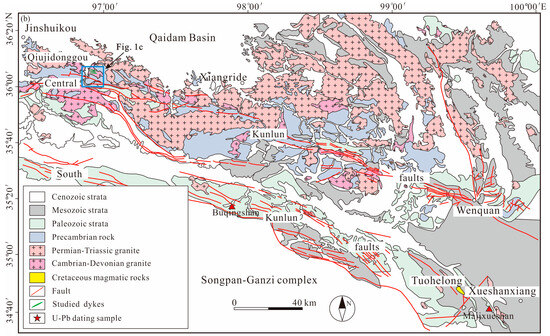
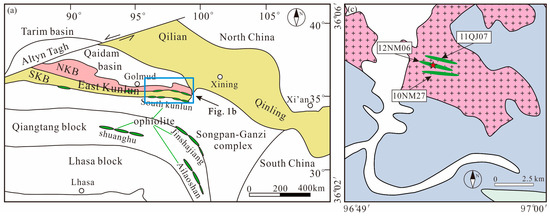
Figure 1.
(a) Tectonic outline of the EKO (modified after [22]); (b) simplified geological map showing the distribution of granitoids in the EKO (modified after [23]); (c) simplified geological map showing sample localities.
The basement of the NKB mainly consists of the Archean–Paleoproterozoic Baishahe Formation, Mesoproterozoic Xiaomiao Formation and Neoproterozoic Binggou Group [24,25]. The NKB is mainly characterized by widespread Early Paleozoic–Early Devonian and Late Permian–Early Mesozoic igneous rocks [2]. Unconformably overlying the basement is the Late Devonian Maoniushan red molasse formation, which consists of clastic and carbonate rocks interbedded with continental pyroclastic rocks [26]. The basement of the SKB mainly includes the Mesoproterozoic Kuhai Complex and Wanbaogou Group, which is covered by the Devonian Maoniushan formation unconformity [26]. In addition, there are also small amounts of Early Paleozoic and Middle–Late Triassic granitoid rocks in the SKB [27].
The studied mafic dykes were identified in Qiujidonggou, in the NKB, and intrude into the Devonian granitic pluton with a 10 cm wide chilled margin (Figure 1b,c; Figure 2a,b). The coordinates of the mafic dykes are 96°51′14″ E, 36°3′40″ N. Dozens of dykes can be seen in the field, and the width varies from 0.5m to 2m. The nine samples studied were collected from three representative dykes. The mafic dykes comprise diabase and diabase porphyry and exhibit an ophitic texture, mainly containing the minerals clinopyroxene (40%) and plagioclase (55%) in addition to minor opaque minerals (5%) (Figure 2c,d).
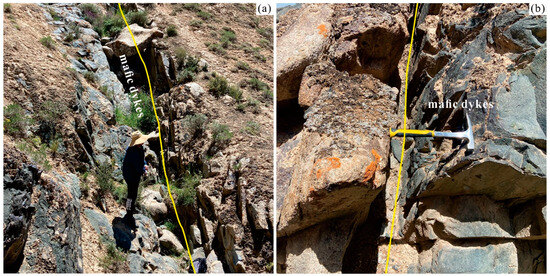
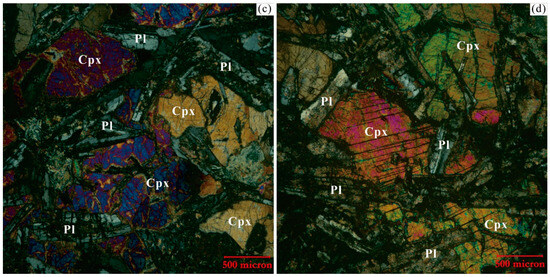
Figure 2.
Field and microscope graphics of the mafic dykes in the EKO. (a,b) Field photographs of the mafic dykes; (c,d) microphotographs of the mafic dykes. Mineral abbreviations: Cpx—Clinopyroxene; Pl—Plagioclase.
3. Analytical Methods
3.1. LA-ICP-MS Zircon U-Pb Dating
All the research samples were collected from fresh rock outcrops in the field, and the analysis was carried out at the State Key Laboratory of Geological Processes and Mineral Resources (GPMR), China University of Geosciences, Wuhan. Zircons were separated through the use of heavy liquids and using a Frantz magnetic separator. The transmitted light, reflected light and cathodoluminescence (CL) images of zircons were used to observe the internal structure. Laser sampling was performed using a GeoLas 2005. An Agilent 7500a ICP-MS instrument (Agilent Technologies Inc., Santa Clara, California, America) was used to acquire ion-signal intensities. Zircon 91500 and GJ-1 were used as external standards for U-Pb dating and trace element correction, respectively. The background acquisition time of each measurement was 20~30 s, and the data acquisition time was 50 s. Helium was applied as a carrier gas, and Ar was used as the makeup gas and mixed with the carrier gas via a T-connector before entering the ICP source. The data were processed using ICPMSDataCal [28]. Concordia diagrams and weighted mean ages were made using Isoplot/Ex_ver3 [29]. The detailed operating conditions for the laser system and ICP-MS instrument are described by Liu et al. [28].
3.2. Whole-Rock Major and Trace Element Analyses
Whole-rock geochemical analysis was completed at the GPMR. Major elements were analyzed with the standard X-ray fluorescence method and carried out on a Shimadzu XRF-1800 spectrometer (Shimadzu, Tokyo, Japan) with a precision of <3% and an accuracy of <4%. The detailed techniques for major element analysis are described by Ma et al. [30]. The trace element compositions were determined using an Agilent 7700a ICP-MS (Agilent Technologies Inc., California, America) with analytical precision ranging from 5% to 10%. The samples were digested by HF + HNO3 in Teflon bombs. Analyses of USGS standards (AGV-2, BHVO-2, BCR-2 and RGM-2) indicate accuracy better than 5%~10% for most trace elements. The sample digestion procedures and ICP-MS methods used are those described by Liu et al. [31].
3.3. Whole-Rock Sr-Nd Isotopes
Sr–Nd isotope analyses were performed on a Finnigan MAT-261 thermal ionization mass spectrometer (TIMS) (ThermoFinnigan, San Jose, California, America) at the GPMR in China University of Geosciences. The analytical precision and accuracy for Sr–Nd isotopic compositions are as described by Gao et al. [32].
4. Results
4.1. LA-ICP-MS Zircon U-Pb Isotopic Data
Zircon U-Pb dating was carried out on the representative sample 12NM06-2. Zircon U-Pb isotopic data and calculated ages are listed in Supplementary Table S1. Most zircons were euhedral to subhedral, prismatic and transparent with crystal lengths ranging from 100 to 200 μm and aspect ratios (length-to-width) of approximately 2:1 to 3:1 (Figure 3a). The analyzed zircons had identical zoning and commonly showed clear oscillatory zoning in CL images (Figure 3a). All the analyzed zircons (do not include the following excluded zircons) had high contents of Th (828~3995 ppm) and U (1408~6816 ppm) with high Th/U ratios (0.27~1.73), further suggesting their magmatic origins [33]. A total of thirty zircons were analyzed in this study. Among them, three zircons with poor concordance are removed. In the remaining zircons, there are two young zircons with low Th (240 and 412 ppm), U (528 and 8924 ppm) content and Th/U (0.45 and 0.05) ratio. They have irregular crystal shapes and cloud-like internal structures in CL images, indicating that they may have been metasomatic by late hydrothermal fluids. After excluding two young zircons and four zircons with large errors, the other samples had apparent 206Pb/238U ages of 80.88 ± 0.67 Ma (Figure 3b), with a weighted mean 206Pb/238U age of 80.90 ± 0.75 Ma (Figure 3c), which was explained as the crystallization age of the studied mafic dykes.

Figure 3.
(a) Representative CL images of zircons and (b,c) U-Pb Concordia diagrams for mafic dykes in the EKO. The blue circles represent points with large errors.
4.2. Whole-Rock Major and Trace Element Geochemistry
Major and trace element data for the studied Cretaceous mafic dykes in the EKO are listed in Supplementary Table S2. The studied rocks had narrow variations of SiO2 (46.36 wt.%~47.40 wt.%), MgO (6.79 wt.%~7.38 wt.%), TiO2 (1.91 wt.%~2.13 wt.%) and CaO (8.72 wt.%~9.22 wt.%). The mafic dykes had low total alkali (K2O + Na2O) content (4.22 wt.%~4.89 wt.%), with Na2O/K2O ratios varying from 1.64 to 2.87, which belong to the sodic series. In a Zr/TiO2 vs. Nb/Y plot (Figure 4a), the mafic dykes were plotted into the subalkaline field, with compositions similar to basalt.
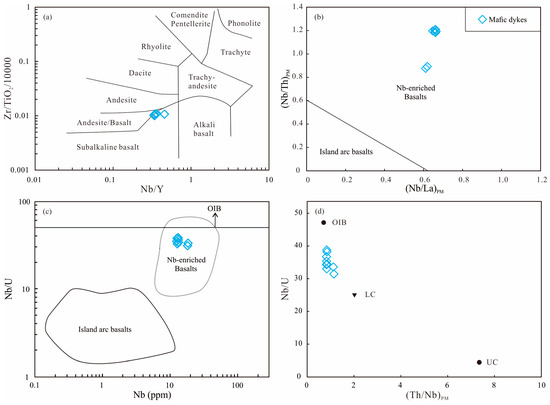
Figure 4.
(a) Zr/TiO2/10000 vs. Nb/Y discrimination diagram showing rock type and magma series, after [34]; (b) (Nb/Th)PM vs. (Nb/La)PM diagram, after [35]; (c) Nb/U vs. Nb diagram, after [36]; (d) Nb/U vs. (Th/Nb)PM diagram indicates the role crustal contamination. PM—primitive mantle normalized [37]; OIB—ocean island basalt [37]; LC—lower crust; UC—upper crust, after [38].
On the chondrite-normalized rare earth element (REE) diagram (Figure 5a), the mafic dykes have high total REE (162~220 ppm) and are enriched in light rare earth elements (LREE) ((La/Yb)N = 3.55~5.37) without obvious Eu anomalies (δEu = 0.87~0.97), similar to OIB. In the primitive mantle normalized multi-element diagram (Figure 5b), the mafic dykes are enriched in large ion lithophile elements (LILEs) (Rb, Ba, K) and depleted in high-field-strength elements (HFSEs) (Nb, Ta, Hf), which are not identical to the OIB but similar to island arc basalts. In addition, the Nb contents (12.4~18.3 ppm), Nb/La (0.63~0.69) and Nb/U ratios (31.46~38.80) of the mafic dykes are significantly higher than those of island arc basalts and have stronger affinity with Nb-enriched basalts (Figure 4b,c).
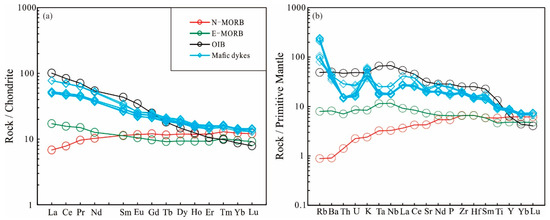
Figure 5.
Chondrite-normalized REE patterns (a) and primitive mantle-normalized element spider diagram (b) for the mafic dykes. Chondrite REE abundances are after [39], and trace element abundances for the primitive mantle are after [37]. The values of OIB, E-MORB and N-MORB are after [37].
4.3. Whole-Rock Sr-Nd
The Sr-Nd isotopic data for the mafic dykes are given in Supplementary Table S3, calculated to 80 Ma for all the samples. The mafic dykes had 87Sr/86Sr ratios of 0.706727 to 0.709888 and 143Nd/144Nd ratios of 0.512596 to 0.512677, with initial (87Sr/86Sr)i ratios of 0.705696 to 0.708718, εNd(t) values of −0.18 to +1.33 and single-stage Nd model ages of 0.948 to 1.112 Ga.
5. Discussion
5.1. Effects of Alteration
Post-magmatic processes, such as hydrothermal alteration and metamorphism, can disturb the primary geochemical compositions of igneous rocks. Thus, the potential influence of post-magmatic alteration should be evaluated before using geochemical data for petrogenic study. The studied mafic dykes did not display any deformational structures or mineral recrystallization at the outcrop to the mineral scale (Figure 2a–d). Petrographic observation indicated that the primary igneous textures remained intact, and the preponderance of the samples was devoid of secondary calc-silicate minerals (epidote, calcite) or metamorphic recrystallization textures. Although sericitization occurred in some plagioclase crystals (Figure 2c,d), the measured loss on ignition (LOI) values were below 2 wt.% (except for 11QJ07-6 (2.02 wt.%) and 11QJ07-7 (2.03 wt.%) samples). The samples have a high 87Sr/86Sr values. It is found that there are two main reasons for the high 87Sr/86Sr value: (1) the sample originated from a Sr-enriched source [40], (2) the sample is affected by rock–water interactions [41]. In thin sections, it can be seen that the feldspar alteration of mafic dykes is serious, with different degrees of sericitization, indicating that they may be affected by rock–water interactions to a certain extent, which is also the main reason for the high 87Sr/86Sr values of the samples. In addition, no samples showed obvious Ce anomalies (Ce/Ce* = 1.02~1.06), and their REE distribution patterns were also identical (Figure 5a). In diagrams of K2O vs. LOI and 87Sr/86Sr vs. LOI (Figure 6a,b), the samples also did not show positive correlations. The above petrography and geochemistry data suggest that the studied samples have not experienced extensive hydrothermal alteration and metamorphism; thus, their whole-rock geochemical data can be effectively used to decipher their petrogenesis.
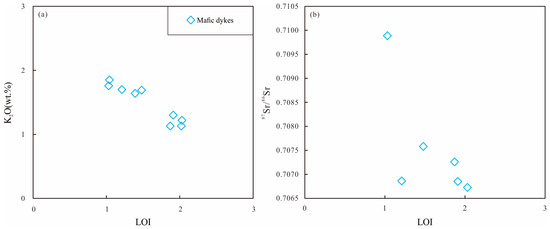
Figure 6.
(a) K2O vs. LOI and (b) 87Sr/86Sr vs. LOI diagrams for studied mafic dykes.
5.2. Crustal Contamination
Mantle-derived magma ascending or resident in the continental crustal environment will experience different degrees of crustal contamination; therefore, the influence of crustal contamination should be evaluated before discussing the magmatic source characteristics of the samples. The mafic dykes have experienced only slight crustal contamination, which can be seen from the following points:
(1) The mafic dykes had lower SiO2 (46.36 wt.%~47.40 wt.%) contents and a narrow variation range, high values of Mg# (53–55) and high Cr (57~134 ppm) and Ni (66~87 ppm) contents. Data analysis showed that there was no obvious linear relationship between SiO2 and Mg#, Cr, Ni and εNd(t), indicating that the mafic dykes had not experienced significant crustal contamination. (2) As the Ce/Y ratio is sensitive to crustal contamination, albeit not significantly affected by crystallization differentiation, the small variation in Ce/Y (Ce/Y = 1.20~1.66) ratios of the samples suggests that they are not significantly contaminated [42]. (3) The Zr/Hf (43.64~46.50) and Nb/Ta (16.82~17.91) values of the mafic dykes were significantly higher than those of the continental crust (Zr/Hf = 33.2, Nb/Ta = 10.9) [43], similar to the primitive mantle (Zr/Hf = 36.2, Nb/Ta = 17.3) [43], indicating that the mafic dykes were not obviously contaminated by the crust. (4) In the Nb/U vs. (Th/Nb)PM diagram, the studied rocks do not show the trend of crustal contamination (Figure 4d). (5) The depleted and narrow εNd(t) value (−0.18~1.33) also indicates that the mafic dykes have experienced only slight crustal contamination.
5.3. Petrogenesis of the Cretaceous Nb-Enriched Mafic Dykes in the EKO
Whole-rock εNd(t) values of the studied mafic dykes were slightly depleted (−0.18~1.33), which is similar to those of magmatic rocks originating from the lithosphere and crust–mantle mixing in the EKO, but obviously different from coeval alkaline basalts originating from the asthenosphere mantle in the adjacent Duofutun area of the West Qinling orogen (Figure 7b). The mafic dykes had low contents of SiO2 (46.36 wt.%~47.40 wt.%) and high contents of MgO (6.79 wt.%~7.38 wt.%), V (181~216 ppm), Cr (57~134 ppm) and Ni (66~87 ppm), precluding the model of crust–mantle mixing. The ratios of incompatible elements, e.g., La/Nb and La/Ta, are usually adopted to constrain the mantle affinities [37,44]. The high La/Nb (1.45~1.58) and La/Ta (24.77~27.71) ratios of the studied mafic dykes indicate that they likely originated from the lithospheric mantle (La/Nb > 1 and La/Ta > 20). Thus, we suggest that the mafic dykes originated from the lithospheric mantle. Mantle peridotite usually contains various types and amounts of aluminum-rich phases at different depths; that is, plagioclase at low pressures, spinel at medium pressures and garnet at higher pressures [37]. The partition coefficients of REEs in these aluminum-rich minerals are significantly different; therefore, the ratio of HREEs and LREEs (such as Dy/Yb, Tb/Yb) can reflect the type of mantle source and the degree of partial melting [45]. The Dy/Yb ratios of the mafic dykes ranged from 1.81 to 2.13, indicating that the magma may have originated from the partial melting of the spinel–garnet mantle (spinel mantle: Dy/Yb < 1.5; garnet mantle: Dy/Yb > 2) [46]. The results show that garnet enriches HREE more preferentially than MREE, so garnet as the residual phase will lead to a higher MREE/HREE ratio in magma [47]. The MREE of mafic dykes in Qiujidonggou was enriched relative to HREE, and the (Gd/Yb)N and (Tb/Yb)N ratios ranged from 1.48 to 1.73 and 1.28 to 1.47, respectively, indicating the existence of garnet in the mantle source. In the (Sm/Yb)N vs. (La/Sm)N diagram (Figure 7a), the samples show that they originated from the partial melting of spinel lherzolite and may contain little garnet.
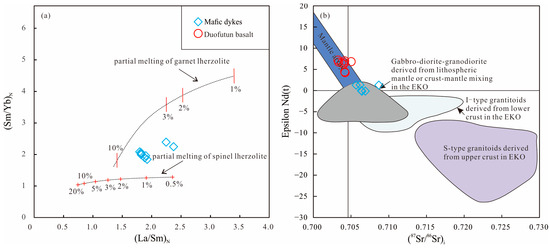
Figure 7.
(a) (Sm/Yb)N vs. (La/Sm)N for mafic dykes in the EKO. Detailed calculations are provided by Chen et al. [48]. (b) Initial (87Sr/86Sr)i vs. εNd(t) diagram. Isotopic fields compiled by Xiong et al. [6] are plotted for comparison. Data sources are from Li et al. [49].
The EKO mafic dykes had high contents of Nb (12.4~18.3 ppm), Nb/La (0.63~0.69) and Nb/U (31.46~38.80) ratios, which is similar to Nb-enriched basalt (Figure 4b,c). Previous studies have suggested that the main genetic models of Nb-enriched basalts include: (1) partial melting of a mantle wedge metasomatized by slab melt [50]; (2) magma mixing between OIB-like melt and depleted MORB-type melt [17]; (3) partial melt of subducted seamounts [51]; and (4) partial melting of an enriched mantle [36]. Geochemical data show that mafic dykes are rich in LILEs and depleted in HFSEs, which have the characteristics of arc magmatic rocks [52]. Previous studies have shown that crustal contamination and enrichment of the source are the main reasons for the formation of arc magmatic rocks [53,54,55]. As mentioned earlier, the studied mafic dykes had not been strongly contaminated by the crust, so the arc magmatic rock characteristics of the samples may have been caused by the enrichment of the source. The metasomatism of subducted slab-related fluids or melts is the main factor leading to the enrichment of the mantle source [56]. LREEs and HFSEs have different chemical behaviors in subduction-related fluids and melts, so the ratios of these elements can be used to distinguish the properties of enriched metasomatism components in the source region [20,57,58]. The Ba/La and Ba/Th values of mafic dykes are low, which are significantly different from those of magmatic rocks derived from subduction fluid metasomatism [57]. Meanwhile, the metasomatism of subduction-related melts will lead to the enrichment of Th and the increase in La/Sm values in the mantle source [56,58]. The mafic dykes have high contents of Th (1.2~2.5 ppm) and high values of La/Sm (2.86~3.77), which also indicates that the source experienced metasomatism of subduction-related melts. In the Th/Yb vs. Nb/Yb and Th/Yb vs. Ta/Yb diagrams, the mafic dykes also show the addition of subducted slab melts in the source (Figure 8a,b). In addition, the Sr-Nd isotopic composition of the mafic dykes deviated from the typical depleted mantle value, which also indicates the addition of related subducted sediment components in the source (Figure 7b). Thus, we suggest that the source of mafic dykes may have experienced metasomatism dominated by subducted sediments. Previous research data show that the Paleo-Tethys Ocean in the EKO entered the intracontinental orogenic stage in the late Triassic [4,5,6]. Thus, the Nb-enriched mafic dykes in the EKO are unlikely to be derived from the partial melting of a mantle wedge metasomatized by slab melt and the partial melting of the subducted seamounts. Nb-enriched basalts originating from the magma mixing between OIB-like melt and depleted MORB-type melt generally do not deplete HFSEs [37], while mafic dykes obviously deplete HFSEs (Nb, Ta, Hf). Thus, the mafic dykes are unlikely to have originated from the mixing between OIB-like melt and depleted MORB-type melt. Combined with the regional geological data, we suggest that the studied mafic dykes are more likely to have originated from the partial melting of the enriched mantle; that is, the decompression melting of the lithospheric mantle modified by the previous subducted sediments.
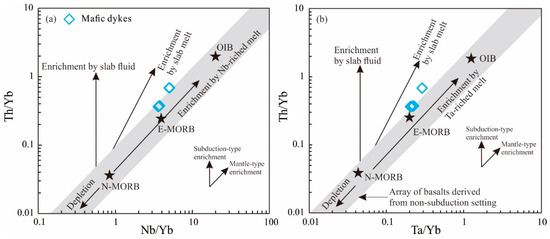
Figure 8.
(a) Th/Yb vs. Nb/Yb, and (b) Th/Yb vs. Ta/Yb for mafic dykes in the EKO. The value of N-MORB, E-MORB and OIB are from [37], the melt or fluid-related enrichment trends are after [58].
5.4. Tectonic Implications
Previous studies reveal that the Nb-enriched mafic rocks are a tectonic method of reconstructing evolutionary history [16,19,59]. The studied mafic dykes were enriched in LREEs and depleted in HREEs (Figure 5a,b). They had high contents of Nb (12.4~18.3 ppm) and Ta (0.7~1.0 ppm) and high ratios of Nb/U (31~39) without obvious Eu anomalies (δEu = 0.87~0.97). In contrast, the studied dykes had geochemical affinities similar to the OIB. In the tectonic discriminant diagram, the mafic dykes were all located in the intraplate area (Figure 9a,b), indicating that the samples originated from the intraplate extensional environment. It was found that the genetic mechanisms of intraplate basic rocks are mainly as follows: (1) mantle plume [60]; (2) thermal disturbance of subducted slab [61]; (3) lithosphere rejuvenation [62]; (4) slab rollback [63]; (5) lithosphere delamination [64]; and (6) back-arc extension caused by slab subduction [65]. Research data have shown that there was no mantle plume activity in the EKO during the Cretaceous, so the studied mafic dykes could not have formed in the mantle plume environment. Meanwhile, the Paleo-Tethys Ocean in the EKO entered the intracontinental orogenic stage in the late Triassic [4,5,6]. Thus, the mafic dykes cannot be formed in the environment of thermal disturbance of subducted slab, slab rollback and back-arc extension caused by slab subduction. In addition, during the Cretaceous, there were no magmatic rocks, such as adakitic rocks, clearly indicating the delamination of the tectonic environment in the EKO, so the studied mafic dykes could not be formed in the lithosphere delamination environment. Previous studies have shown that strong tectonic strike-slip activities occurred in the EKO during the late Cretaceous [7,8,9,10,66], and there may be a lithosphere rejuvenation. Thus, we suggest that the studied mafic dykes in the EKO are more likely to be formed during the rejuvenation of the lithosphere.
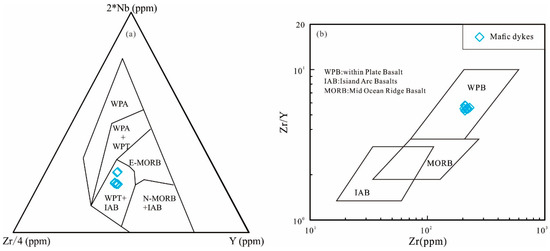
Figure 9.
Tectonic discrimination diagrams for the studied mafic dykes. (a) 2*Nb-Zr/4-Y diagram after [67]. (b) Zr/Y vs. Zr after [68].
The discovery of Buqingshan and Dur’ngoi ophiolites in the EKO indicates that the Paleo-Tethys Ocean began to expand as early as the Carboniferous [69,70]. The determination of a large number of Permian–Middle Triassic back-arc basalts and island arc granites indicates the continuation of subduction [3,71,72,73,74], while the discovery of Middle–Late Triassic syn-collision granites indicates the closure of the Paleo-Tethys Ocean [4,5,6]. After the late Triassic, the EKO entered the intracontinental evolution stage, and there was no obvious orogeny. Previous studies on the Altun fault on the west side of the EKO show that the Altun fault has the characteristics of multi-stage re-activation [75]. Among them, a strong tectonic strike-slip activity occurred in the Altun fault at about 80 Ma. Based on the study of single minerals in the Altun fault by Sobel et al. [9], it is found that K-feldspars have the 40Ar/39Ar thermochronological ages of the late Cretaceous (76, 83, 84 Ma). Meanwhile, Robinson et al. also discovered late Cretaceous granite in the Tula area on the east side of the Altun fault (86.2 ± 2.2, 74.5 ± 2.2, 74.9 ± 1.7, 74.7 ± 1.6 Ma) [76]. In addition, in the Hongliuxia area at the western end of the thrust fault on the northern margin of the Qilian Mountains on the northern margin of the EKO, the single mineral plagioclase in the trachyte also has an 40Ar/39Ar thermochronological age of the late Cretaceous (82 Ma) [8]. Meanwhile, there are also 40Ar/39Ar thermochronological records (~80 to 100 Ma) of the late Cretaceous in the volcanic rocks near Duofutun [7]. The above information indicates that there was strong tectonic activity in the EKO during the late Cretaceous and there may be a lithosphere rejuvenation in the EKO. The mafic dykes in the EKO may have been formed in the process of lithosphere rejuvenation, that is, the activity of the strike-slip fault in the EKO caused the decompression melting of the enriched mantle in the lower lithosphere, the upwelling of the enriched mantle, and the upward migration of melt along the deep fault, and finally emplaced and crystallized to form the Qiujidonggou mafic dykes.
6. Conclusions
(1) Geochronological studies show that the studied mafic dykes in the EKO have a crystallization age of 80.9 ± 0.75 Ma and are products of Cretaceous magmatism.
(2) The studied Cretaceous mafic dykes exhibit Nb-enriched basalt affinities and slightly depleted εNd(t) values, suggesting their origin from the partial melting of the lithospheric mantle. The mafic dykes are rich in LILEs and depleted in HFSEs, with high Nb contents and moderate Dy/Yb ratios, indicating that they are from a partial melting of spinel lherzolite and a little of garnet, which was metasomatized by previously subducted sediments.
(3) The mafic dykes have high 87Sr/86Sr values, and feldspar is a serious alteration in thin sections, which may be affected by rock–water interactions, to a certain extent.
(4) Tectonic studies reveal that the studied Nb-enriched mafic dykes were formed in an intraplate environment and may be the product of partial melting of the enriched mantle in the lower lithosphere caused by the activity of the EKO strike-slip fault in the late Cretaceous.
Supplementary Materials
The following supporting information can be downloaded at: https://www.mdpi.com/article/10.3390/min14010089/s1, Table S1: LA-ICP-MS zircon U-Pb data for the studied mafic dykes in Qiujidonggou; Table S2: Whole-rock major and trace element compositions of the studied mafic dykes in Qiujidonggou; Table S3: Whole-rock Sr-Nd isotopic compositions for the mafic dykes in Qiujidonggou.
Author Contributions
Conceptualization, Z.C. and F.X.; methodology, M.W.; software, J.Z.; validation, Z.C., H.Z. and J.Z.; formal analysis, J.Z.; investigation, Z.C. and H.Z.; resources, F.X.; data curation, M.W.; writing—original draft preparation, Z.C. and H.Z.; writing—review and editing, Z.C. and H.Z.; visualization, J.Z.; supervision, M.W.; project administration, F.X.; funding acquisition, F.X. All authors have read and agreed to the published version of the manuscript.
Funding
This study was financially supported by the National Natural Science Foundation of China (No. 41602049) and the Research Project of Chengdu University of Technology (No. 2022ZF11412).
Data Availability Statement
The original contributions presented in this study are included in the article/Supplementary Material.
Acknowledgments
We sincerely thank the journal editor and three anonymous reviewers for their constructive comments and suggestions, which substantially improved our manuscript.
Conflicts of Interest
The authors declare no conflict of interest.
References
- Dong, Y.P.; He, D.F.; Sun, S.S.; Liu, X.M.; Zhou, X.H.; Zhang, F.F.; Yang, Z.; Cheng, B.; Zhao, G.C.; Li, J.H. Subduction and accretionary tectonics of the East Kunlun orogen, western segment of the Central China Orogenic System. Earth Sci. Rev. 2018, 186, 231–261. [Google Scholar] [CrossRef]
- Mo, X.X.; Luo, Z.H.; Deng, J.F.; Yu, X.H.; Liu, C.D.; Chen, H.W.; Yuan, W.M.; Liu, Y.H. Granitoids and Crustal Growth in the East-Kunlun Orogenic Belt. Geol. J. China Univ. 2007, 13, 403. [Google Scholar]
- Xiong, F.; Ma, C.; Chen, B.; Ducea, M.N.; Hou, M.; Ni, S. Intermediate-mafic dikes in the East Kunlun Orogen, Northern Tibetan Plateau: A window into paleo-arc magma feeding system. Lithos 2019, 340, 152–165. [Google Scholar] [CrossRef]
- Wang, P.; Zhao, G.; Liu, Q.; Yao, J.; Han, Y. Evolution of the Paleo-Tethys Ocean in Eastern Kunlun, North Tibetan Plateau: From continental rift-drift to final closure. Lithos 2022, 422, 106717. [Google Scholar] [CrossRef]
- Gao, H.; Sun, F. Middle to Late Triassic granitic magmatism in the East Kunlun orogenic belt, NW China: Petrogenesis and implications for a transition from subduction to post-collision setting of the Palaeo-Tethys Ocean. Geol. J. 2021, 56, 3378–3395. [Google Scholar] [CrossRef]
- Xiong, F.; Ma, C.; Zhang, J.; Liu, B.; Jiang, H.A. Reworking of old continental lithosphere: An important crustal evolution mechanism in orogenic belts, as evidenced by Triassic I-type granitoids in the East Kunlun orogen, Northern Tibetan Plateau. J. Geol. Soc. London 2014, 171, 847–863. [Google Scholar] [CrossRef]
- Craddock, W.H.; Kirby, E.; Dewen, Z.; Liu, J.L. Tectonic setting of Cretaceous basins on the NE Tibetan Plateau: Insights from the Jungong basin. Basin Res. 2012, 24, 51–69. [Google Scholar] [CrossRef]
- Yang, J.S.; Meng, F.C.; Zhang, J.X.; Li, H.B. The shoshonitic volcanic rocks at Hongliuxia: Pulses of the Altyn Tagh in Cretaceous. Sci. China Ser. D 2001, 31, 83–89. [Google Scholar] [CrossRef]
- Sobel, E.R.; Arnaud, N.; Jolivet, M.; Ritts, B.D.; Brunel, M. Jurassic to Cenozoic exhumation history of the Altyn Tagh range, northwest China, constrained by 40Ar/39Ar and apatite fission track thermochronology. Geol. Soc. Am. Mem. 2001, 194, 247–267. [Google Scholar]
- Chen, X.; Yuan, W.; Xu, J.; Wang, K.; Yuan, E.; Feng, Z. Tectonic activities in Dongshangen polymetallic ore district, eastern Kunlun Mountains, Qinghai-Tibet Plateau: Evidences from fission track thermochronology. Ore Geol. Rev. 2019, 112, 103065. [Google Scholar] [CrossRef]
- Wu, C.; Zuza, A.V.; Zhou, Z.; Yin, A.; McRivette, M.W.; Chen, X.; Ding, L.; Geng, J.Z. Mesozoic-Cenozoic evolution of the Eastern Kunlun Range, central Tibet, and implications for basin evolution during the Indo-Asian collision. Lithosphere 2019, 11, 524–550. [Google Scholar] [CrossRef]
- Wu, C.; Zuza, A.V.; Li, J.; Haproff, P.J.; Yin, A.; Chen, X.; Ding, L.; Li, B. Late Mesozoic–Cenozoic cooling history of the northeastern Tibetan Plateau and its foreland derived from low-temperature thermochronology. Bulletin 2021, 133, 2393–2417. [Google Scholar] [CrossRef]
- Sajona, F.G.; Maury, R.C.; Bellon, H.; Cotton, J.; Defant, M.J.; Pubellier, M. Initiation of subduction and the generation of slab melts in western and eastern Mindanao, Philippines. Geology 1993, 21, 1007–1010. [Google Scholar] [CrossRef]
- Keppler, H. Constraints from partitioning experiments on the composition of subduction-zone fluids. Nature 1996, 380, 237–240. [Google Scholar] [CrossRef]
- Zhang, T.; Deng, J.; Wang, M.; Li, C.; Zhang, L.; Sun, W. Geochemistry and genesis of the Nadun Nb-enriched arc basalt in the Duolong mineral district, western Tibet: Indication of ridge subduction. Geosci Front. 2022, 13, 101283. [Google Scholar] [CrossRef]
- Guo, F.; Wu, Y.; Zhang, B.; Zhang, X.; Zhao, L.; Liao, J. Magmatic responses to Cretaceous subduction and tearing of the paleo-Pacific Plate in SE China: An overview. Earth. Sci. Rev. 2021, 212, 103448. [Google Scholar] [CrossRef]
- Castillo, P.R.; Rigby, S.J.; Solidum, R.U. Origin of high field strength element enrichment in volcanic arcs: Geochemical evidence from the Sulu Arc, southern Philippines. Lithos 2007, 97, 271–288. [Google Scholar] [CrossRef]
- Liu, H.; Wang, Y.; Cawood, P.A.; Guo, X. Episodic slab rollback and back-arc extension in the Yunnan-Burma region: Insights from Cretaceous Nb-enriched and oceanic-island basalt–like mafic rocks. Bulletin 2017, 129, 698–714. [Google Scholar] [CrossRef]
- Chen, F.; Cui, X.; Lin, S.; Wang, J.; Ren, G.; Li, K. The earliest Neoproterozoic Nb-enriched mafic magmatism indicates subduction tectonics in the southwestern Yangtze Block, South China. Precambrian Res. 2023, 384, 106938. [Google Scholar] [CrossRef]
- Xiong, F.; Liu, Q.; Hou, M.; Yan, S. Petrogenesis of Neoproterozoic mafic dykes in western Yangtze Block, South China: Implications for the assembly and break-up of Rodinia. Int. Geol. Rev. 2023, 65, 2191–2211. [Google Scholar] [CrossRef]
- Xu, Z.; Yang, J.; Jiang, M.; Li, H.; Xue, G.; Yuan, X. Deep structure and lithospheric shear faults in the East Kunlun-Qiangtang region, northern Tibetan Plateau. Sci. China Ser. D Earth Sci. 2001, 44, 1–9. [Google Scholar] [CrossRef]
- Meng, F.; Zhang, J.; Cui, M. Discovery of Early Paleozoic eclogite from the East Kunlun, Western China and its tectonic significance. Gondwana Res. 2013, 23, 825–836. [Google Scholar] [CrossRef]
- Xiong, F.; Ma, C.; Jiang, H.A.; Zhang, H. Geochronology and petrogenesis of Triassic high-K calc-alkaline granodiorites in the East Kunlun orogen, West China: Juvenile lower crustal melting during post-collisional extension. J. Earth Sci. 2016, 27, 474–490. [Google Scholar] [CrossRef]
- Guocan, W.; Nengsong, C.; Yunhai, Z.; Kexin, Z. Late Caledonian ductile thrusting deformation in the Central East Kunlun Belt, Qinghai, China and its significance: Evidence from geochronology. Acta Geol. Sin.-Engl. Ed. 2003, 77, 311–319. [Google Scholar] [CrossRef]
- Chen, N.; Sun, M.; He, L.; Zhang, K.; Wang, G. Precise timing of the Early Paleozoic metamorphism and thrust deformation in the Eastern Kunlun Orogen. Chin. Sci. Bull. 2002, 47, 1130–1133. [Google Scholar] [CrossRef]
- Xiong, F.; Ma, C.; Liu, B.; Huang, J. Geochronology and geochemistry of Middle Devonian mafic dykes in the East Kunlun orogenic belt, Northern Tibet Plateau: Implications for the transition from Prototethys to Paleotethys orogeny. Geochemistry 2014, 74, 225–235. [Google Scholar] [CrossRef]
- Liu, H. Petrology, geochemistry and geochronology of late Triassic volcanics, Kunlun orogenic belt, western China: Implications for tectonic setting and petrogenesis. Geochem. J. 2005, 39, 1–20. [Google Scholar] [CrossRef]
- Liu, Y.; Gao, S.; Hu, Z.; Gao, C.; Zong, K.; Wang, D. Continental and oceanic crust recycling-induced melt–peridotite interactions in the Trans-North China Orogen: U–Pb dating, Hf isotopes and trace elements in zircons from mantle xenoliths. J. Petrol. 2010, 51, 537–571. [Google Scholar] [CrossRef]
- Ludwig, K.R. User’s Manual for IsoPlot 3.0. A Geochronological Toolkit for Microsoft Excel; Special Publication; Berkeley Geochronology Center: Berkeley, CA, USA, 2003. [Google Scholar]
- Ma, Q.; Zheng, J.; Griffin, W.L.; Zhang, M.; Tang, H.; Su, Y. Triassic “adakitic” rocks in an extensional setting (North China): Melts from the cratonic lower crust. Lithos 2012, 149, 159–173. [Google Scholar] [CrossRef]
- Liu, Y.; Hu, Z.; Gao, S.; Günther, D.; Xu, J.; Gao, C. In situ analysis of major and trace elements of anhydrous minerals by LA-ICP-MS without applying an internal standard. Chem. Geol. 2008, 257, 34–43. [Google Scholar] [CrossRef]
- Gao, S.; Rudnick, R.L.; Yuan, H.L.; Liu, X.M.; Liu, Y.S.; Xu, W.L.; Ling, W.L.; Ayers, J.; Wang, X.C.; Wang, Q.H. Recycling lower continental crust in the North China craton. Nature 2004, 432, 892–897. [Google Scholar] [CrossRef] [PubMed]
- Corfu, F.; Hanchar, J.M.; Hoskin, P.W.; Kinny, P. Atlas of zircon textures. Rev. Mineral. Geochem. 2003, 53, 469–500. [Google Scholar] [CrossRef]
- Winchester, J.A.; Floyd, P.A. Geochemical discrimination of different magma series and their differentiation products using immobile elements. Chem. Geol. 1977, 20, 325–343. [Google Scholar] [CrossRef]
- Polat, A.; Kerrich, R. Magnesian andesites, Nb-enriched basalt-andesites, and adakites from late-Archean 2.7 Ga Wawa greenstone belts, Superior Province, Canada: Implications for late Archean subduction zone petrogenetic processes. Contrib. Mineral. Petrol. 2001, 141, 36–52. [Google Scholar] [CrossRef]
- Kepezhinskas, P.; Defant, M.J.; Drummond, M.S. Progressive enrichment of island arc mantle by melt-peridotite interaction inferred from Kamchatka xenoliths. Geochim. Cosmochim. Acta 1996, 60, 1217–1229. [Google Scholar] [CrossRef]
- Sun, S.; McDonough, W.F. Chemical and isotopic systematics of oceanic basalts: Implications for mantle composition and processes. Geol. Soc. Lond. Spec. Publ. 1989, 42, 313–345. [Google Scholar] [CrossRef]
- Rudnick, R.L.; Gao, S.; Holland, H.D.; Turekian, K.K. The crust. In Treatise on Geochemistry; Elsevier: Oxford, UK, 2003; Volume 3, pp. 1–64. [Google Scholar]
- Taylor, S.R.; McLennan, S.M. The Continental Crust: Its Composition and Evolution; Oxford Press: Blackwell, UK, 1985; pp. 1–312. [Google Scholar]
- Ferrara, G.; Preite-Martinez, M.; Taylor, H.P.; Tonarini, S.; Turi, B. Evidence for crustal assimilation, mixing of magmas, and a 87Sr-rich upper mantle: An oxygen and strontium isotope study of the M. Vulsini volcanic area, Central Italy. Contrib. Mineral. Petrol. 1986, 92, 269–280. [Google Scholar] [CrossRef]
- McNutt, R.H. 87Sr/86Sr as indicators for rock-water interactions: Applications to brines found in Precambrian age rocks from Canada. In Saline Water and Gases in Crystalline Rocks; Geological Association of Canada Memorial University: St. John’s, NL, Canada, 1987; pp. 81–88. [Google Scholar]
- Conly, A.G.; Brenan, J.M.; Bellon, H.; Scott, S.D. Arc to rift transitional volcanism in the Santa Rosalia region, Baja California Sur, Mexico. J. Volcanol. Geotherm. Res. 2005, 142, 303–341. [Google Scholar] [CrossRef]
- Rudnick, R.L.; Fountain, D.M. Nature and composition of the continental crust: A lower crustal perspective. Rev. Geophys. 1995, 33, 267–309. [Google Scholar] [CrossRef]
- Fan, H.; Zhou, J.; Huang, Z.; Wu, T.; Zhang, H. Ca. 830 Ma alkaline mafic dykes in the southeastern Guizhou Province, South China: New constraints on the Neoproterozoic evolution of the Yangtze Block. Precambrian Res. 2023, 389, 107032. [Google Scholar] [CrossRef]
- Aldanmaz, E.; Pearce, J.A. Thirlwall MF, Mitchell JG. Petrogenetic evolution of late Cenozoic, post-collision volcanism in western Anatolia, Turkey. J. Volcanol. Geotherm. Res. 2000, 102, 67–95. [Google Scholar] [CrossRef]
- Ma, L.; Jiang, S.; Hofmann, A.W.; Dai, B.; Hou, M.; Zhao, K. Lithospheric and asthenospheric sources of lamprophyres in the Jiaodong Peninsula: A consequence of rapid lithospheric thinning beneath the North China Craton? Geochim. Cosmochim. Acta 2014, 124, 250–271. [Google Scholar] [CrossRef]
- Brombin, V.; Bonadiman, C.; Jourdan, F.; Roghi, G.; Coltorti, M.; Webb, L.E. Intraplate magmatism at a convergent plate boundary: The case of the Cenozoic northern Adria magmatism. Earth. Sci. Rev. 2019, 192, 355–378. [Google Scholar] [CrossRef]
- Chen, S.S.; Shi, R.D.; Fan, W.M.; Gong, X.H.; Wu, K. Early Permian mafic dikes in the Nagqu area, central Tibet, China, as-sociated with embryonic oceanic crust of the Meso-Tethys Ocean. J. Geophys. Res. Solid Earth 2017, 122, 4172–4190. [Google Scholar] [CrossRef]
- Li, X.; Mo, X.; Yu, X.; Ding, Y.; Huang, X.; Wei, P. Geochronological, geochemical and Sr–Nd–Hf isotopic constraints on the origin of the Cretaceous intraplate volcanism in West Qinling, Central China: Implications for asthenosphere–lithosphere interaction. Lithos 2013, 177, 381–401. [Google Scholar] [CrossRef]
- Zhang, Y.; Yuan, C.; Sun, M.; Long, X.; Huang, Z.; Jiang, Y. Two late Carboniferous belts of Nb-enriched mafic magmatism in the Eastern Tianshan: Heterogeneous mantle sources and geodynamic implications. GSA Bull. 2020, 132, 1863–1880. [Google Scholar] [CrossRef]
- Deng, J.; Zhang, L.; Liu, H.; Liu, H.; Liao, R.; Mastoi, A.S. Geochemistry of subducted metabasites exhumed from the Mariana forearc: Implications for Pacific seamount subduction. Geosci. Front. 2021, 12, 101117. [Google Scholar] [CrossRef]
- Brown, G.C.; Thorpe, R.S.; Webb, P.C. The geochemical characteristics of granitoids in contrasting arcs and comments on magma sources. J. Geol. Soc. London 1984, 141, 413–426. [Google Scholar] [CrossRef]
- Zheng, Y.; Zhou, Y.; Zhai, M.; Wang, X.; Deng, X.; Liu, R. Ca. 2.1 Ga low-δ18O gabbro-diorite association in southern North China Craton: Implications for an intraplate rifting. Lithos 2022, 430, 106858. [Google Scholar] [CrossRef]
- Jahn, B.; Wu, F.; Lo, C.; Tsai, C. Crust–mantle interaction induced by deep subduction of the continental crust: Geochemical and Sr–Nd isotopic evidence from post-collisional mafic–ultramafic intrusions of the northern Dabie complex, central China. Chem. Geol. 1999, 157, 119–146. [Google Scholar] [CrossRef]
- Gill, J.B. Orogenic Andesites and Plate Tectonics; Spring: Berlin/Heidelberg, Germany, 1981; Volume 16, pp. 230–247. [Google Scholar]
- Zhao, J.; Zhou, M.; Wu, Y.; Zheng, J.; Wang, W. Coupled evolution of Neoproterozoic arc mafic magmatism and mantle wedge in the western margin of the South China Craton. Contrib. Mineral. Petrol. 2019, 174, 1–16. [Google Scholar] [CrossRef]
- Tatsumi, Y. High-Mg andesites in the Setouchi volcanic belt, southwestern Japan: Analogy to Archean magmatism and continental crust formation? Annu. Rev. Earth. Planet. Sci. 2006, 34, 467–499. [Google Scholar] [CrossRef]
- Pearce, J.A. Geochemical fingerprinting of oceanic basalts with applications to ophiolite classification and the search for Archean oceanic crust. Lithos 2008, 100, 14–48. [Google Scholar] [CrossRef]
- Xu, J.; Xia, X.P.; Lai, C.K.; Zhou, M.; Ma, P. First identification of Late Permian Nb-enriched basalts in Ailaoshan region (SW Yunnan, China): Contribution from Emeishan plume to subduction of eastern Paleotethys. Geophys. Res. Lett. 2019, 46, 2511–2523. [Google Scholar] [CrossRef]
- Niu, Y. Some basic concepts and problems on the petrogenesis of intra-plate ocean island basalts. Chin. Sci. Bull. 2009, 54, 4148–4160. [Google Scholar] [CrossRef]
- Liu, D.; Zhao, L.; Yuan, H.; Sun, W.; Xiao, W. Receiver function mapping of the mantle transition zone beneath the Tian Shan orogenic belt. J. Geophys. Res. Solid Earth 2022, 127, e2022JB024635. [Google Scholar] [CrossRef]
- Li, W.; Chen, Y.; Yuan, X.; Xiao, W.; Windley, B.F. Intracontinental deformation of the Tianshan Orogen in response to India-Asia collision. Nat. Commun. 2022, 13, 3738. [Google Scholar] [CrossRef]
- Pirajno, F.; Santosh, M. Rifting, intraplate magmatism, mineral systems and mantle dynamics in central-east Eurasia: An overview. Ore. Geol. Rev. 2014, 63, 265–295. [Google Scholar] [CrossRef]
- Comeau, M.J.; Stein, C.; Becken, M.; Hansen, U. Geodynamic modeling of lithospheric removal and surface deformation: Application to intraplate uplift in Central Mongolia. J. Geophys. Res. Solid Earth 2021, 126, e2020JB021304. [Google Scholar] [CrossRef]
- Ma, L.; Wang, Q.; Wyman, D.A.; Jiang, Z.Q.; Wu, F.Y.; Li, X.H.; Yang, J.H.; Guo, G.N.; Guo, H.F. Late Cretaceous back-arc extension and arc system evolution in the Gangdese area, southern Tibet: Geochronological, petrological, and Sr-Nd-Hf-O isotopic evidence from Dagze diabases. J. Geophys. Res. Solid Earth 2015, 120, 6159–6181. [Google Scholar] [CrossRef]
- Wu, Z.; Barosh, P.J.; Ye, P.; Hu, D. Late Cretaceous tectonic framework of the Tibetan Plateau. J. Asian Earth Sci. 2015, 114, 693–703. [Google Scholar] [CrossRef]
- Meschede, M. A method of discriminating between different types of mid-ocean ridge basalts and continental tholeiites with the Nb 1bZr 1bY diagram. Chem. Geol. 1986, 56, 207–218. [Google Scholar] [CrossRef]
- Pearce, J.A.; Norry, M.J. Petrogenetic implications of Ti, Zr, Y, and Nb variations in volcanic rocks. Contrib. Mineral. Petrol. 1979, 69, 33–47. [Google Scholar] [CrossRef]
- Bian, Q.T.; Luo, X.Q.; Li, D.H.; Zhao, D.S.; Chen, H.H.; Xu, G.Z.; Chang, C.F.; Gao, Y.L. Geochemistry and Formation Environment of the Buqingshan Ophiolite Complex, Qinghai Province, China. Acta Gelogica Sin. 2001, 75, 45–55. [Google Scholar]
- Yang, J.S.; Wang, X.B.; Shi, R.D.; Xu, Z.Q.; Wu, C.L. The Dur’ngoi ophiolite in East Kunlun, northern Qinghai-tibet Plateau: A fragment of paleo-Tethyan oceanic crust. Geol. China 2004, 31, 225–239. [Google Scholar]
- Xu, C.; Zhao, X.; Huizenga, J.M.; Wei, J.; Zhou, H.; Wang, F.; Zhang, X.M. Petrogenesis of Permian to Triassic granitoids from the East Kunlun orogenic belt: Implications for crustal evolution during oceanic subduction and continental collision. Int. Geol. Rev. 2023, 65, 1781–1799. [Google Scholar] [CrossRef]
- Li, R.B.; Pei, X.Z.; Li, Z.C.; Pei, L.; Chen, G.H.; Liu, Z.Q.; Chen, Y.X.; Liu, C.J.; Wang, M.; Zhang, M. Paleo-Tethyan Ocean Evolution and Indosinian Orogenesis in the East Kunlun Orogen, Northern Tibetan Plateau. Minerals 2022, 12, 1590. [Google Scholar] [CrossRef]
- Xin, W.; Sun, F.; Zhang, Y.; Fan, X.; Wang, Y.; Li, L. Mafic–intermediate igneous rocks in the East Kunlun Orogenic Belt, northwestern China: Petrogenesis and implications for regional geodynamic evolution during the Triassic. Lithos 2019, 346, 105159. [Google Scholar] [CrossRef]
- Zhang, J.; Yu, M.; Wang, H.; Li, B.; Feng, C.; Dick, J.M.; Li, J.C.; Kong, H.L.; Zhao, Z.Y. Geodynamic Setting and Cu-Ni Potential of Late Permian Xiwanggou Mafic-Ultramafic Rocks, East Kunlun Orogenic Belt, NW China. Front. Earth. Sci. 2021, 9, 666967. [Google Scholar] [CrossRef]
- Liu, Y.; Neubauer, F.; Genser, J.; Ge, X.; Takasu, A.; Yuan, S.; Chang, L.; Li, W. Geochronology of the initiation and displacement of the Altyn Strike-Slip Fault, western China. J. Asian Earth Sci. 2007, 29, 243–252. [Google Scholar] [CrossRef]
- Robinson, D.M.; Dupont-Nivet, G.; Gehrels, G.E.; Zhang, Y. The Tula uplift, northwestern China: Evidence for regional tectonism of the northern Tibetan Plateau during late Mesozoic–early Cenozoic time. Geol. Soc. Am. Bull. 2003, 115, 35–47. [Google Scholar] [CrossRef]
Disclaimer/Publisher’s Note: The statements, opinions and data contained in all publications are solely those of the individual author(s) and contributor(s) and not of MDPI and/or the editor(s). MDPI and/or the editor(s) disclaim responsibility for any injury to people or property resulting from any ideas, methods, instructions or products referred to in the content. |
© 2024 by the authors. Licensee MDPI, Basel, Switzerland. This article is an open access article distributed under the terms and conditions of the Creative Commons Attribution (CC BY) license (https://creativecommons.org/licenses/by/4.0/).